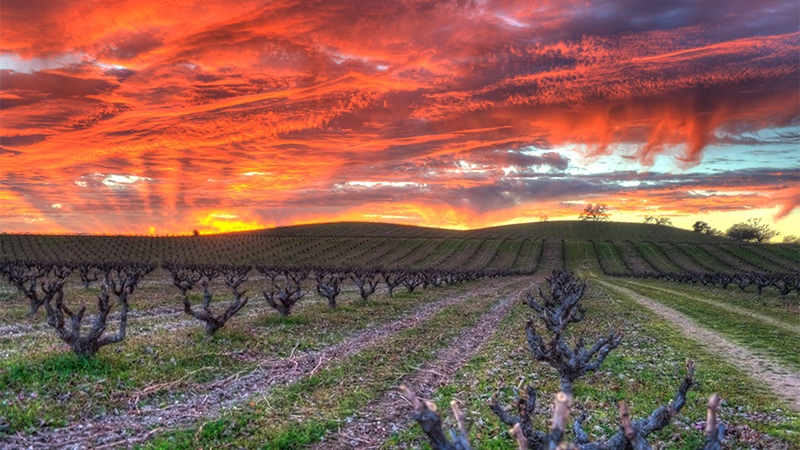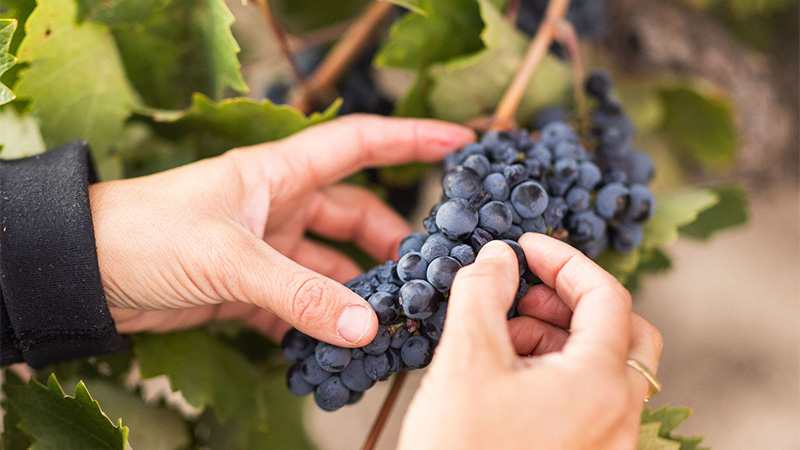
California is known for its wine country, but beyond the household names like Napa Valley lies Paso Robles, a Central Coast wine region quickly growing into one of the best in the state.
Why? In addition to the powerhouse Cabernet Sauvignon and Rhône blends they are known for, winemakers are producing rare varieties that can be hard to find in California.
“Paso’s strength is in its diversity,” says Christopher Taranto, communications director of the Paso Robles Wine Country Alliance. “We learned long ago that our region doesn’t have to adhere to the old paradigm of being about one variety or style.”
Taranto sums it up best: Embrace the unexpected. Paso Robles crafts distinctive flavor profiles thanks to its many microclimates. The wine region, north of Santa Barbara County and south of the Santa Lucia Highlands in Monterey, sits inland from the ocean, giving it an overall warmer climate. But the rolling hills and cool evenings produce just the right diurnal swing to produce many outstanding wines.
Winemakers Experiment With Grapes From Around the World
One heritage variety here is Zinfandel, which was first commercially produced in Paso Robles as far back as the 1880s. The thick-skinned dark grape thrives in the region’s hot days and chilly nights, creating a soft and round version of Zinfandel that’s often more approachable than the intensely flavored or high-alcohol versions found in other areas. It put Paso Robles on the world wine map from the start.
“What sets us apart is our ability to grow almost any warm-climate grape as good as anywhere else in the world,” says Ryan Pease, winemaker at Paix Sur Terre. “When you have a Mediterranean climate and limestone soils, you have the most desirable conditions for viticulture anyone could ask for. Our ability to grow world-class Counoise, Zinfandel, or Cabernet Sauvignon, even in the same vineyard, is achievable at very high quality.”
Today, what differentiates Paso is more than its beloved Zinfandel — it is the wide array of wines the region produces. Of the 40,000 acres under vine, there are 60 independent wine grape varieties, ranging from the popular southern Italian variety Aglianico to the lesser-known Counoise, a blending grape found in France’s Rhône Valley. Winemakers in the area do make standout Cabernet-based blends, but this experimentation with obscure (to California) grapes has proved to be promising in the long run for the future of the region — and its devotees.
“We can showcase the potential of the region that speaks to all wine enthusiasts,” Taranto says, noting that the mesoclimate, varying hillside aspects, and high pH soils allow the “talented growers and makers to embrace all the wine styles and varieties.” That broadens their reach to wine drinkers with many palate preferences.
Paso’s Diverse Wines Pair With Central Coast Cuisine in Unexpected Ways
Paso wines are very approachable on the whole, especially when it comes to food. The vast spectrum of aromas and flavors in the dozens of varieties means pairing potential with everything from the neighborhood taco stand to the ocean-to-table fine-dining restaurants along the Central Coast and throughout the wine country.
Though wine grapes far exceed other agricultural provisions, Paso Robles has long been a basin for an assortment of crops including almonds and olives, as well as cattle. Whipping up a grilled ratatouille is an easy meal, and when paired with Alicante Bouschet from Villa San-Juliette Vineyard & Winery, an elevated experience.
“The ability to take more esoteric varieties, like Alicante Bouschet, and transform them from blending components to stand-alone varietals is what will keep Paso relevant for generations,” says Dan Smith, winemaker at Villa San- Juliette. “We’re still in full discovery mode about elevating these unconventional flavor profiles and that makes it an exciting time to enjoy Paso Robles wine.”
The red grape, indigenous to the Languedoc in France and planted in abundance in the Alentejo region of Portugal, here gains more intensity and earthy complexity. The luscious and dense mouthfeel unfolds to layers of red fruit, bold spices, and chalky tannins that complement the richness of caramelized vegetables.
If there is one dish the Central Coast is known for, however, it’s the shellfish, specifically oysters and sea urchins. Winemakers in Paso are no strangers to the briny mollusks and creamy delicacy, which is why some specialize in “oyster grapes” like Ugni Blanc, Vermentino, and Picpoul Blanc.
Ugni Blanc is best known for its use in the production of Cognac in France, but when planted here, presents more seaside and mineral character. Similar to Muscadet, Paix Sur Terre’s Ugni Blanc showcases salinity to match that of the briny oysters, and the wine’s citrus and fruit notes, backed by the essence of sea spray, make it a complement to sea urchin sashimi and plenty of other shellfish dishes.
Likewise, the Paso Verde — a play on Portugal’s Vinho Verde — from Robert Hall Winery calls to mind warm, seaside days with its light-bodied, low-alcohol white wine blend made for drinking all afternoon. Here, winemaker Amanda Gorter combines four Mediterranean grape varieties that all excel in the extreme temperature swings of the area: Grenache Blanc, Verdelho, Vermentino, and Picpoul Blanc. Like Ugni Blanc, it pairs well with shellfish but also with heartier fish dishes such as scallop empanadas. Or, simply, warm aperitif-hour sun.
Counoise produces a red wine filled with bright aromatics — orange peel, cranberry, allspice — and ripe fruit on the palate — cherry, persimmon, pomegranate — that makes drinking a red on a hot day all the more pleasurable. It also works with seafood, like linguine alle vongole (clams), making use of yet another standard California ingredient, and a common pairing for the team at Barton Family Wines, who cleverly label their Counoise “Hot Blooded.”
You also cannot discuss California cuisine without making mention of tacos al pastor, which is what makes Lagrein, a red grape that hails from South Tyrol in northern Italy, a favorite here. Pelletiere Estate Vineyard and Wine makes a luscious, complex, and rich Lagrein that can stand up to the mosaic of flavors of the refined Mexican dish, which includes heat from guajillo chiles and jalapeños, sweetness from the pineapple, and umami from a collection of herbs and spices.
Terret Noir is a barely known grape, one of the 18 permitted in France’s Châteauneuf-du-Pape appellation. Even there, it’s not widely used, so it’s very surprising to see it pop up in Paso. Here, it thrives. Paso’s Tablas Creek Vineyard propagated theirs from cuttings originating at Château de Beaucastel, and they add it to their own red blends as well as a varietal bottling that they have produced for the past five vintages. The garnet-hued wine offers aromatics of watermelon rind, juniper berry, and rose petal, with salty and tangy flavors that finish with grippy tannins and peppery spice. It’s like a meal in and of itself but goes particularly well with Mediterranean dishes like Lebanese lamb meatballs, where the spice and high acid of the wine stand up to the rich meat dish.
And if you’re in the mood for a Napoli-style pizza or a pasta arrabbiata (but when are we not?) reach for a bottle of Giornata’s Aglianico. Paso’s climate matches that of its southern Italian home, with direct sunlight and a long growing season, allowing the grape to ripen smoothly over time. The resulting wine, filled with notes of leather, spice, violet, and dried blueberries, can stand up to a dusting of red pepper flakes on either dish.
Though food and wine are taken seriously in Paso Robles, the overall culture in the region is laid back. Restaurants and tasting rooms tend to eschew formality for friendly vibes that invite you to be a part of the Paso culture: an alfresco meal in the cool evening weather filled with great conversation and, always, another glass of wine.
This article is sponsored by Paso Robles Wine Country Alliance.




